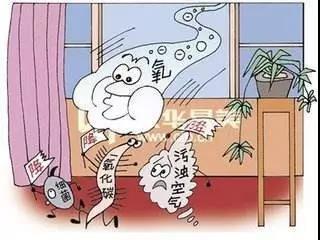
Those things about indoor pollution
Author: Li Deng environmental protection
A series of questions that have to be said about indoor pollution
[Indoor invisible pollution is no less harmful than smog]
Let us tell you about the indoor pollutants!

Inhalable particulate matter generally refers to particulate matter (or PM10) having a particle size below 10 microns, and PM2.5 is also commonly referred to herein. PM10 can enter the upper and lower respiratory tract of the human body, and finer particles (PM2.5 and PM0.1) can penetrate deep into the lungs and even enter the blood circulation through the alveoli. At the same time, fine particles are likely to be enriched in heavy metals, acidic oxides, organic pollutants (such as polycyclic aromatic hydrocarbons, pesticides, etc.), and may also be carriers of bacteria and fungi, which are extremely harmful to humans.
The source of indoor particulate matter is mainly indoor pollution discharge and outdoor pollution infiltration.
Indoor particulate matter is mainly polluted by human activities such as smoking, cooking, cleaning, office, and decoration. Among them, tobacco and cooking are the main sources of pollution of ultra-fine particles and fine particles in indoor environments; indoor activities have a great influence on the concentration of particulate matter, such as cleaning, office and decoration, which is the source of pollution of coarse particles in indoor environment.
Outdoor pollution infiltration Outdoor infiltration is another important source of indoor particulate matter; outdoor particulate matter has different sources and particle sizes vary. In the towns and cities, because China's urban construction is at the peak of construction, construction projects, urban cleaning, motor vehicle exhaust, wind and sand dust, etc. produce more particulate pollution, and the penetration of indoor pollution through the construction gap is relatively large; in rural areas, the main pollution of particulate matter Sources include: road construction, burning wood, straw, living coal, and other high-pollution, low-efficiency fuels.
particulates

Gaseous pollutants Gaseous pollutants are generally classified into four types: volatile organic gases (benzene, formaldehyde, toluene, TVOC, etc.), radioactive gas pollution (helium), ozone, and indoor odor.
VOCs are mainly from indoor combustion products such as coal and natural gas, smoke from smoking, heating and cooking, construction and decorative materials, furniture, household appliances, automotive interior parts, detergents and human body emissions. In the interior decoration process, VOC mainly comes from paints, coatings and adhesives, and solvent-based release agents.
The radioactive material present in the room is mainly helium. Helium is the only natural radioactive inert gas produced by the decay of radium. It has no color and no smell. At room temperature, ammonia can form a radioactive aerosol in the air and pollute the air, which is easily trapped by the respiratory system and accumulates in the lungs to induce lung cancer.
The biggest source of indoor ozone pollution we might not have imagined, the answer is the copier. The working principle of the copier is voltage discharge, let the toner cartridge be charged, and then form a latent print through the light, and finally complete the copy... Of course, this is more difficult to understand, but it does not matter, the key is that the high-pressure mercury lamp and electric spark inside it will emit a lot of ultraviolet light, The oxygen in the air decomposes to form ozone, which is harmful to human health.
The indoor odor mainly includes musty smell, cigarette smell, decoration odor, kitchen odor, paint smell, room smell, garbage odor, bathroom odor, floral odor, other life odor. The best way to get rid of indoor odor is to ventilate. Therefore, when the outdoor air quality is generally good and the temperature is suitable for ventilation, it should be properly ventilated.
Gaseous pollutant

Microorganisms Microbial contamination in indoor environments includes bacteria, fungi, filter viruses, and dust mites. These types of pollutants come from a variety of sources. From the perspective of the survey, in the current office buildings and families, there are several types of indoor air biological pollution factors that can cause health damage such as allergic diseases and respiratory diseases:
microorganism

Molds Molds are microorganisms that can multiply rapidly in warm and humid environments. Some of them can cause symptoms such as nausea, vomiting, and abdominal pain, which can cause serious respiratory and intestinal diseases.
Aphids Aphids are one of the most common air micro-organisms and are small arthropods that are not easily visible to the naked eye. Dust mites are one of the chief culprits of allergic diseases. The amount of dust mites in the indoor air is related to the temperature, humidity and cleanliness of the room.
Legionella Legionella is a type of bacteria that can be found in natural freshwater and artificial pipelines and can also survive in the soil. Studies have shown that Legionella can survive in tap water for about 1 year and survive in river water for about 3 months. The incubation period of Legionnaires' disease ranges from 2 to 20 days. The main symptoms are fever, accompanied by chills, muscle pain, headache, cough, chest pain, difficulty breathing, and the mortality rate is as high as 15% to 20%.
According to an international professional team survey, 21% of indoor air quality problems are caused by microbial contamination. According to a survey conducted by the Indoor Environment Monitoring Center of China Interior Decoration Association, 50% of patients with atopic dermatitis are caused by aphids in indoor air.
microorganism


 ┬Ā┬Ā
┬Ā┬Ā